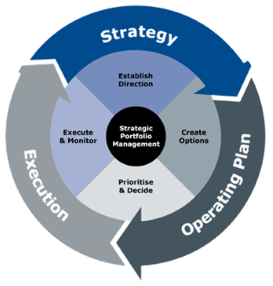
Portfolio Management – Just a Fancy Name?


Do you really know what Portfolio Management is?
It is quite common, in the project management community, to hear and read about Portfolio Management. But are modern organizations really starting to adopt it or is it merely a buzzword? Of course, it is much more than that. Nonetheless, not all people talking about it know exactly what it is. Not even the ones that claim to actually do it.
Many people still confuse Portfolio Management with monitoring and steering the whole set of projects of an organization company. But, if we reduce portfolio management to that, we are basically describing it as enterprise multiproject management, not portfolio management.
So, let's clarify what is, in fact, Portfolio Management.
It’s All About Strategy and Change
As we have referred in a previous blog post, projects assume nowadays a strategic relevance in all organizations. Indeed, they are the main instruments used by modern organizations (public or private) to carry out their strategies. In other words, projects are conceived to deliver the necessary change for organizations to create sustained value, remain competitive or, even, increase their business potential, allowing them to fulfill their strategic goals and, eventually, their vision.
With such fast-paced markets they currently face, organizations need to be in permanent change and, as such, they need to implement lots of projects. But between all the possible projects, which ones should be implemented? This is the purpose or the underlying principle behind Portfolio Management.
Going back to our introduction, while project management focuses on doing projects right, portfolio management focuses on doing the right projects. In a simple phrase, we establish a great difference between the two contexts, that summarizes what some organizations still fail to perceive.

A project portfolio can be defined as a strategy-based and prioritized of all initiatives of an organization, aligned with the organization's resource capacities. More than a discipline, Portfolio Management is a methodology that organizations needs to follow to maximize the business value created by that project mix.

Many people still believe that Portfolio Management is the monitoring and steering of the whole set of projects of an organization company. It's not.
A typical governance framework
So, which methodology should organizations follow?
Most mature organizations typically follow Governance models, which are logical frameworks, defining the processes and rules in which portfolio decisions are made. There are many official frameworks to address this subject, even guidelines on how to build them, from several different bodies and institutions. Not only by Project Management guilds, but also by public entities.
Of course, every business case is a different reality, so the model should always be a bit customized to the organization’s structure and business flows. But no matter which the adopted model is, the main principles behind should not differ.
In order to enable the model, before we define any project mix, the organization needs to know where they want to go, what they want to achieve. Strategic objectives must be outlined from scratch.
Also, the value must be described. If the projects to be implemented are the ones that will create more value, organizations must then understand their own concept of value. With that settled, evaluation criteria are defined and scoring models and prioritization rules can be defined.
Strategy and business value constitute the basic grounds for Portfolio Governance. From those, all models will follow a similar logical framework:

Project Governance Framework
- Step 1. Listing – All running initiatives and possible new fitting candidates are identified and categorized into relevant business groups, where projects can be more easily compared.
- Step 2. Screening – Listed components are evaluated according to the defined criteria, scored and a shortlist of the best candidates is drawn.
- Step 3. Prioritizing – Best candidates are now ranked considering the prioritization rules.
- Step 4. Optimizing – Determine the mix of projects with the greatest potential to deliver business value considering available resources, which are allocated to the projects according to their priorities
- Step 5. Authorizing - Formal approval of the project and allocation of organizational resources
- Step 6. Steering - All necessary activities to manage and control the projects and monitor Portfolio health, in matters of strategy alignment and business value to be created.
That is clear, and now what?
Understanding the rationale of Portfolio Management is crucial for modern organizations’ success, especially the ones more dependent on projects to create value and achieve their goals. It is the job of consulting companies like Proove to create awareness on the subject and trigger the implementation of a proper Portfolio Management model within those organizations.
Of course, on paper, it looks quite easy, but such models must rely on proper tools to be effective. In a following blog post, we will discuss one of these tools and how such a model can be automated with it.


